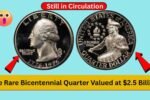Imagine discovering a coin in your pocket change that’s worth a staggering $3.5 million. Sounds like a dream, right? Well, that’s exactly the story surrounding a rare Lincoln Wheat Penny that has taken the numismatic world by storm. While these pennies are a common part of American coin history, certain rare varieties are now worth a small fortune—and the most exciting part? Experts believe a few of these valuable coins might still be in circulation.
In this article, we dive into the fascinating world of the Lincoln Wheat Penny, uncovering its history, identifying features, rare varieties, and how you might just get lucky enough to find one.
A Brief History of the Lincoln Wheat Penny
The Lincoln Wheat Penny, also called the “Wheat Cent,” made its debut in 1909. It was designed by Victor David Brenner and holds the distinction of being the first U.S. coin to feature a real person—President Abraham Lincoln. The coin’s reverse side featured two wheat stalks, symbolizing prosperity, and remained in circulation until 1958, after which it was replaced by the Lincoln Memorial design.
Made primarily from 95% copper, the Wheat Penny was a staple in American currency for decades and has always been a favorite among coin collectors.
Why Are Some Lincoln Wheat Pennies Worth Millions?
While most Lincoln Wheat Pennies are only worth a few cents to a few dollars depending on their condition, a few rare versions can fetch extraordinary sums. The most famous and valuable of these is the 1943 Copper Penny. During World War II, the U.S. Mint switched to steel for penny production to conserve copper for the war effort. However, a small number of copper blanks were mistakenly used, resulting in a handful of 1943 copper pennies.
Because of their rarity, collectors are willing to pay as much as $3.5 million for a well-preserved 1943 copper penny. Other highly sought-after varieties include:
- 1909-S VDB: Produced in limited numbers, with the designer’s initials prominently displayed.
- 1914-D: Scarce and valuable, especially in good condition.
- 1922 No D: A Denver mint penny that mistakenly lacks the “D” mint mark.
Also Read – Bajaj Pulsar NS 200: Has Left Everyone Behind With Its Amazing Power, 65kmpl Mileage And Unique Design
How to Spot a Valuable Lincoln Wheat Penny
Not all Wheat Pennies are created equal. Here’s what you should look for when examining your spare change:
- Check the Date: Look closely at pennies from the early 1900s, especially 1943. A 1943 penny that doesn’t stick to a magnet could be the rare copper variety.
- Mint Marks Matter: Coins with an “S” (San Francisco) or “D” (Denver) under the date may be more valuable, depending on the year.
- Condition Counts: Coins with minimal wear, clear lettering, and no scratches are worth more.
- Look for Errors: Coins with double strikes, missing mint marks, or other minting errors often carry a premium.
Keeping a magnifying glass handy and checking your change regularly could lead to a lucky discovery.
Can These Rare Pennies Still Be Found in Circulation?
Surprisingly, yes. While it’s incredibly rare, people have found valuable Lincoln Wheat Pennies in their pocket change, in old piggy banks, or inside inherited coin collections. Because many people are unaware of the coin’s value, these treasures occasionally slip through the cracks.
Coin roll hunting—where collectors purchase rolls of pennies from banks and sift through them—has also proven fruitful for some lucky enthusiasts.
Real Stories of Discovery
There have been several real-life stories where everyday Americans stumbled upon these rare coins. In some cases, these discoveries turned into life-changing events. Whether you’re an avid collector or simply someone who loves a good treasure hunt, this is all the more reason to check your change.
FAQs About the Lincoln Wheat Penny
Q1. Why is the 1943 Copper Penny so valuable?
A1. Only a few copper pennies were mistakenly minted in 1943, making them extremely rare and highly sought after by collectors.
Q2. How can I test a 1943 penny?
A2. Use a magnet. Steel pennies will stick to it, but a genuine 1943 copper penny will not.
Q3. Can I legally sell a rare Lincoln Wheat Penny?
A3. Absolutely. These coins can be sold legally to collectors, coin dealers, or through auction houses.
Q4. Besides 1943, are there other rare Wheat Pennies?
A4. Yes. Look for the 1909-S VDB, 1914-D, and 1922 No D pennies, all of which are highly valuable.
Q5. Where should I sell a valuable coin?
A5. Use reputable coin dealers, certified auction houses, or online platforms—but always get your coin professionally appraised first.
Final Thoughts
The Lincoln Wheat Penny is not just a piece of old copper; it’s a slice of American history with the potential to be a millionaire-maker. Though the odds of finding one worth $3.5 million are slim, it’s not impossible. Checking your change might be a small act, but the reward could be extraordinary.
So next time you get a handful of pennies, don’t toss them aside. You might just be holding a hidden treasure—a Lincoln Wheat Penny that could change your life.
Some Important Link
| Telegram Group | Click Here |
| WhatsApp Group | Click Here |
| Home Page | Click Here |















